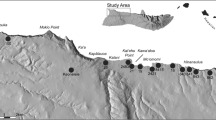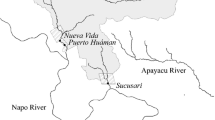Abstract
Native peoples have often been portrayed as natural conservationists, living a “balanced” existence with nature. It is argued that this perspective is a result of an imprecise operational definition of conservation. Conservation is defined here in contrast to the predictions of foraging theory, which assumes that foragers will behave to maximize their short-term harvesting rate. A behavior is deemed conservation when a short-term cost is paid by the resource harvester in exchange for long-term benefits in the form of sustainable harvests. An example of the usefulness of such an operational definition is presented using data on patch and prey choice decisions of a group of subsistence hunters, the Piro of Amazonian Peru. Results indicate that the area around the Piro village is depleted of prey, and that hunters allocate more time to patches where return rates are highest. This response is consistent with both a conservation strategy and foraging theory. Contrary to the expectation of the conservation strategy, however, hunters do not restrain from pursing opportunistically encountered prey in the depleted areas. The implications for conservation policy are briefly discussed.
Similar content being viewed by others
References cited
Allen, R. 1974 Hunting Peoples: Harmony between Community and Environment.Ecologist/Resurgence 4:9.
Altmann, J. 1974 Observational Study of Behavior: Sampling Methods.Behavior 49:227–267.
Alvard, M. 1992a Searching For and Transporting Prey by a Group of Central Place Hunters (Abstract).American Journal of Physical Anthropology (Supplement):43.
1992b Are Indigenous People Necessarily Conservationists? Paper presented at the 91st Annual Meeting of the American Anthropological Association, San Francisco.
1993a Testing the Ecologically Noble Savage Hypothesis: Interspecific Prey Choice by Piro Hunters of Amazonian Peru.Human Ecology 21:355–387.
1993bTesting the Ecologically Noble Savage Hypothesis: Conservation and Subsistence Hunting by the Piro of Amazonian Peru. Ph.D. dissertation, Department of Anthropology, University of New Mexico, Albuquerque.
Alvard, M., and H. Kaplan 1991 Procurement Technology and Prey Mortality among Indigenous Neotropical Hunters. InHuman Predators and Prey Mortality, M. Stiner, ed. Pp. 79–104. Boulder: Westview Press.
Bodley, J. 1990Victims of Progress, third ed. Mountainview, California: Mayfield Publishing.
Borgerhoff Mulder, M., and T. Caro 1985 The Use of Quantitative Observational Techniques in Anthropology.Current Anthropology 26:323–335.
Brownrigg, L. 1985 Native Cultures and Protected Areas: Management Options. InThe Human Dimension in Environmental Planning, J. McNeely and D. Pitt, eds. Pp. 33–44. Gland, Switzerland: International Union for Conservation of Nature and Natural Resources.
Bunyard, P. 1989a Guardians of the Amazon.New Scientist 17:38–41.
1989bThe Colombian Amazon: Policies for the Protection of Its Indigenous Peoples and Their Environment. Cornwall, UK: Ecological Press.
Burnham, P., and R. Ellen, eds. 1979Social and Ecological Systems. New York: Academic Press.
Caughley, G. 1977Analysis of Vertebrate Populations. London: John Wiley and Sons.
Charnov, E. 1976 Optimal Foraging: The Marginal Value Theorem.Theoretical Population Biology 9:129–136.
Clad, J. 1985 Conservation and Indigenous Peoples: A Study of Convergent Interests. InThe Human Dimension in Environmental Planning, J. McNeely and D. Pitt, eds. Pp. 45–62. Gland, Switzerland: International Union for Conservation of Nature and Natural Resources.
Clay, J. 1988Indigenous Peoples and Tropical Forests: Models of Land Use and Management from Latin America. Cambridge: Cultural Survival.
Dasmann, R. 1976 Life-styles and Nature Conservation.Oryx 13:281–286.
Dewar, R. 1984 Extinctions in Madagascar: The Loss of the Subfossil Fauna. InQuaternary Extinctions, P. Martin and R. Klein, eds. Pp. 574–593. Tucson: University of Arizona Press.
Diamond, J. 1986 The Golden Age That Never Was.Discover 9:70–79.
Feit, H. 1973 The Ethno-ecology of the Waswanipi Cree, Or How Hunters Can Handle Their Resources. InCultural Ecology, B. Cox, ed. Pp. 115–125. Toronto: McClelland and Stewart.
Golson, J. 1977 No Room at the Top: Agricultural Intensification in the New Guinea Highlands. InSunda and Sahul: Prehistoric Studies in Southeast Asia, Melanesia and Australia, J. Allen, J. Golson, and R. Jones, eds. Pp. 601–638. London: Academic Press.
Gorsline, J., and L. House 1974 Future Primitive.Planet Forum 3:1–13.
Guthrie, D. 1971 Primitive Man’s Relationship to Nature.BioScience 21:721–723.
Hames, R. 1987 Game Conservation or Efficient Hunting? InThe Question of the Commons, B. McCay and J. Acheson, eds. Pp. 97–102. Tucson: University of Arizona Press.
1991 Wildlife Conservation in Tribal Societies. InBiodiversity: Culture, Conservation and Ecodevelopment, M. Oldfield and J. Alcorn, eds. Pp. 172–199. Boulder: Westview Press.
Hardin, G. 1968 The Tragedy of the Commons.Science 162:1243–1248.
Hayden, B. 1981 Subsistence and Ecology: Adaptations of Modern Hunter/gatherers. InOmnivorous Primates: Gathering and Hunting in Human Evolution, R. Harding and G. Teleki, eds. Pp. 344–421. New York: Colombia University Press.
Heinen, J., and B. Low 1992 Human Behavioral Ecology and Environmental Conservation.Environmental Conservation 19:105–116.
Horton, J. 1984 Red Kangaroos: Last of the Australian Megafauna. InQuaternary Extinctions, P. Martin and R. Klein, eds. Pp. 639–680. Tucson: University of Arizona Press.
Hughes, J. 1983American Indian Ecology. El Paso: Texas Western Press.
Hunn, E. 1982 Mobility as a Factor Limiting Resource Use in the Columbia Plateau of North America. InResource Managers: North American and Australian Huntergatherers, N. Williams and E. Hunn, eds. Pp. 17–43. Boulder: Westview Press.
Johannes, R. 1978 Traditional Marine Conservation Methods in Oceania and Their Demise.Annual Review of Ecology and Systematics 9:349–364.
Johnson, N. 1952 The American Indian as Conservationist.Chronicle of Oklahoma 30:33–40.
Kaplan, H., and K. Hill 1992 The Evolutionary Ecology of Food Acquisition. InEvolutionary Ecology and Human Behavior, E. Smith and B. Winterhalder, eds. Pp. 167–202. New York: Aldine de Gruyter.
Kay, C. 1990Yellowstone’s Northern Elk Herd: A Critical Evaluation of the “Natural Regulation” Paradigm. Ph.D. Dissertation, Utah State University, Logan.
1992 An Alternative Interpretation of the Historical Evidence Relating to the Abundance of Wolves in the Yellowstone Ecosystem. Paper presented at the Second North American Symposium on Wolves: Their Status, Biology and Management, August 25–27, 1992. University of Alberta, Edmonton.
Martin, P. 1984 Prehistoric Overkill. InQuaternary Extinctions, P. Martin and R. Klein, eds. Pp. 354–403. Tucson: University of Arizona Press.
McCay, B., and J. Acheson, eds. 1987The Question of the Commons. Tucson: University of Arizona Press.
McDonald, D. 1977 Food Taboos: A Primitive Environmental Protection Agency.Anthropos 72:734–748.
Meggers, B. 1971Amazonia: Man and Culture in a Counterfeit Paradise. Chicago: Aldine-Atherton.
Meltzer, D. 1993 Pleistocene Peopling of the Americas.Evolutionary Anthropology 5:157–169.
Moore, O. 1957 Divination—A New Perspective.American Anthropologist 59:69–74.
Morauta, L., J. Pernetta, and W. Heaney 1982Traditional Conservation in Papua New Guinea: Implications for Today. Boroko: IASER.
Murray, P. 1984 Extinctions Down Under: A Bestiary of Extinct Australian Late Pleistocene Monotremes and Marsupials. InQuaternary Extinctions, P. Martin and R. Klein, eds. Pp. 639–680. Tucson: University of Arizona Press.
Nelson, R. 1982 A Conservation Ethic and Environment: The Koyukon of Alaska. InResource Managers, N. Williams and E Hunn, eds. Boulder: Westview Press.
Oelschlaeger, M. 1991The Idea of Wilderness: Prehistory to the Age of Ecology. New Haven: Yale University Press.
Olson, S. 1989 Extinction on Islands: Man as a Catastrophe. InConservation for the Twenty-First Century, D. Western and M. Pearl, eds. Pp. 50–53. New York: Oxford University Press.
Orians, G., and N. Pearson 1979 On the Theory of Central Place Foraging. InAnalysis of Ecological Systems, D. Horn, R. Mitchell, and G. Stairs, eds. Pp. 154–177. Columbus: Ohio State University Press.
Pearce, F. 1992 First Aid for the Amazon.New Scientist 3:42–46.
Posey, D. 1985 Native and Indigenous Guidelines for Amazonian Development Strategies: Understanding Biodiversity through Ethnoecology. InChange in the Amazon, J. Hemming, ed. Pp. 156–181. Manchester, England: Manchester University Press.
Powell, J. 1970The Impact of Man on the Vegetation of the Mt. Hagen Region, New Guinea. Ph.D. Dissertation, Australian National University, Canberra.
Pyke, G., H. Pulliam, and E. Charnov 1977 Optimal Foraging: A Selective Review of Theory and Tests.Quarterly Review of Biology 52:137–154.
Redford, K. 1991 The Ecologically Noble Savage.Orion 9:24–29.
Reichel-Dolmatoff, G. 1976 Cosmology as Ecological Analysis: A View from the Rain Forest.Man 11:307–318.
Rogers, A. 1990 Group Selection by Selective Emigration: The Effects of Migration and Kin Structure.American Naturalist 135:398–413.
1991 Conserving Resources for Children.Human Nature 2:73–82.
Ross, E. 1978 Food Taboos, Diet, and Hunting Strategy: The Adaptation to Animals in Amazon Cultural Ecology.Current Anthropology 19:1–36.
Sahlins, M. 1972Stone Age Economics. London: Tavistock.
Schoener, T. 1971 Theory of Feeding Strategies.Annual Review of Ecology and Systematics 2:369–404.
Shepard, P. 1973The Tender Carnivore and the Sacred Game. New York: Scribner.
Simms, S. 1992 Wilderness as Human Landscape. InWilderness Tapestry: An Eclectic Approach to Preservation, S. Zeveloff, L. Vause, and W. McVaugh, eds. Pp. 183–201. Reno: University of Nevada Press.
Smith, E. 1983 Anthropological Applications of Optimal Foraging Theory: A Critical Theory.Current Anthropology 24:625–651.
1992Inujjuamiut Foraging Strategies: Evolutionary Ecology of an Arctic Hunting Economy. New York: Aldine de Gruyter.
Snyder, G. 1977The Old Ways. San Francisco: City Lights.
Steadman, D., and S. Olson 1985 Bird Remains from an Archaeological Site on Henderson Island, South Pacific: Man-Caused Extinctions on an “Uninhabited” Island.Proceedings of the National Academy of Sciences 82:6191–6195.
Stephens, D., and J. Krebs 1986Foraging Theory. Princeton: Princeton University Press.
Strong, D. 1973 The Indian and the Environment.Journal of Environmental Education 5:49–51.
Tattersall, I. 1982The Primates of Madagascar. New York: Colombia University Press.
Taylor, K. 1991 Deforestation and Indians in Brazilian Amazonia. InBiodiversity, E. O. Wilson, ed. Pp. 138–144. Washington, D.C.: National Academy Press.
Todd, J. 1986Earth Dwelling: The Hopi Environmental Ethos and Its Architectural Symbolism—A Model for the Deep Ecology Movement. Ph.D. Dissertation, University of California at Santa Cruz.
Trotter, M., and B. McCulloch 1984 Moas, Men and Middens. InQuaternary Extinctions: A Prehistoric Revolution, P. Martin and R. Klein, eds. Pp. 708–727. Tucson: University of Arizona Press.
Vecsey, C., and R. Venables 1980American Indian Environments. Syracuse, New York: Syracuse University Press.
Wheat, J. 1972The Olsen-Chubbock Site: A Paleo-Indian Bison Kill. Society for American Archeology Memoir 26.
Williams, G. 1966Adaptation and Natural Selection. Princeton: Princeton University Press.
Wilson, D. S. 1983 The Group Selection Controversy: History and Current Status.Annual Review of Ecology and Systematics 14:159–187.
Winterhalder, B., W. Baillargeon, F. Cappelletto, I. Daniel, and C. Prescott 1988 The Population Ecology of Hunter-gatherers and Their Prey.Journal of Anthropological Archaeology 7:289–328.
Wood, A., and G. Humphreys 1982 Traditional Soil Conservation in Papua New Guinea. InTraditional Conservation in Papua New Guinea: Implications for Today, L. Morauta, J. Pernetta, and W. Heaney, eds. Boroko: IASER.
Wynne-Edwards, V. 1962Animal Dispersion in Relation to Social Behavior. New York: Hafner.
Author information
Authors and Affiliations
Additional information
Michael Alvard received his Ph.D. at the University of New Mexico in 1993 and is currently an assistant professor of anthropology at Dickinson College. His interests include the impact of traditional hunting on prey species and the evolution of conservation. He is currently pursuing research opportunities with the Wana, a group of subsistence hunters living in the rain forests of Sulawesi, Indonesia.
Rights and permissions
About this article
Cite this article
Alvard, M.S. Conservation by native peoples. Human Nature 5, 127–154 (1994). https://doi.org/10.1007/BF02692158
Received:
Accepted:
Issue Date:
DOI: https://doi.org/10.1007/BF02692158




